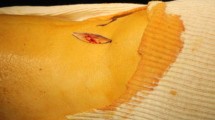Abstract
Surgical correction of bowed legs should be performed as early as possible. Overload osteoarthritis, even without significant varus deformity of the knee, is a further indication for open-wedge high-tibial osteotomy. Progression of damage to the joint surfaces due to overloading can be significantly retarded by realigning the extremity with the aim to, at least, reduce overload on the medial compartment to a value close to physiological. Significant improvement to open-wedge high-tibial osteotomy (OWHTO) has been made on two fronts: (a) by the use of a more appropriate surgical technique and (b) by promoting osteogenesis through an angular-stable fixation device with just the correct amount of elasticity. A retrospective study of 53 consecutive cases in which no interposition material was used to fill the wedge, with gap openings between 5 mm and 20 mm, showed that ossification of the gap always progressed from the lateral hinge towards the medial side. Standard radiographs showed 75% of the gap filled in with new bone within 6−18 months. In conclusion, we believe that open-wedge high-tibial osteotomy using the TomoFix® plate has proved to be successful in treating unicompartmental gonarthrosis, even without bone grafts or bone-substitute material.





Similar content being viewed by others
References
Agneskirchner JD, Hurschler C, Wrann CD, Lobenhoffer P (2007) The effects of valgus medial open wedge high tibial osteotomy on articular cartilage pressue of the knee: a biomechanical study. Arthroscopy 23:852–861
Aydoğdu S, Cullu E, Arac N, Varolgüneş N, Sur N (2000) Prolonged proneal nerve dysfunction after high tibial osteotomy: pre- and postoperative electrophysiological study. Knee Surg Sports Traumatol Arthrosc 8:305–308
van Bekerom MPJ, Patt TW, Kleinhout MY, van Vis HM, Albers GHR (2008) Early complications after high tibial osteotomy: a comparison of two techniques. J Knee Surg 21:68–74
Brinkman J-M, Lobenhoffer P, Agneskirchner JD, Staubli AE, Wymega AB, van Heerwarden RJ (2008) Osteotomies around the knee. J Bone Joint Surg Br 90-B:1548–1557
Coventry MB (1965) Osteotomy of the upper portion of the tibia for degenerative arthritis of the knee. A preliminary report. J Bone Joint Surg 47:984–990
De Simoni C, Staubli AE (2000) Neue Fixationstechnik für medial open-wedge Osteotomien der proximalen Tibia. Schweiz Med Wochenzeitschrift 119:130
Fick R (1911) Handbuch der Anatomie und Mechanik der Gelenke, Teil 3. Gustav Fischer, Jena
Fujisawa Y, Masuhara K, Shiomio S (1979) The effect of high tibial osteotomy on osteoarthritis of the knee. An arthroscopic stuy of 54 knee joints. Orthop Clin North Am 10:585–608
Heller MO, Taylor WR, Perka C, Duda GN (2003) The influence of alignment on the musculo-skeletal loading conditions at the knee. Langenbecks Arch Surg 388:291–297
Hernigou P, Medeveielle D, Debeyre J, Goutallier D (1987) Proximal tibial osteotomy for osteoarthritis with varus deformity. A ten to thirteen-year follow-up study. J Bone Joint Surg Am 69:332–354
Lobenhoffer P, van Heerwarden RJ, Staubli AE, Jakob RP (2008) Osteotomies around the knee. Thieme, Stuttgart and New York
Morrison JB (1968) Bioengineering analysis of force actions transmitted by the knee joint. Bio-Med Eng 4:164–170
Mündermann A, Dyrby CO, D’Lima DD, Colwell CW, Andriacchi TP (2008) In vivo knee loading characteristics during activities of daily living as measured by an instrumented total knee replacement. J Orthop Res: 1167–1172
Nelissen EM, van Langelaan EJ, Nelissen RGHH (2009) Stability of medial opening wedge high tibial osteotomy: a failure analysis. Int Orthop Feb 3. doi:10.1007/s00264-009-0723-3
Odenbring S, Tjönstrand B, Egund N, Hagstedt B, Hovelius L (1989) Function after tibial osteotomy for medial gonarthrosis below aged 50 years. Acta Orthop Scand 60:527–531
Paul JP (1976) Loading on normal hip and knee joints and on joint replacements. In: Schaldach M, Hohmann D (eds) Advances in artificial hip and knee joint technology. Springer, Berlin, Heidelberg and New York
Rozbruch SR, Parvizi J, Hanssen AD, Spangehl MJ (2004) Total knee arthroplasty following proximal tibial osteotomy. Reply. J Bone Joint Surg (Am) 86:2571
Perren SM (2002) Evolution of the internal fixation of long bone fractures. The scientific basis of biological internal fixation: choosing a balance between stability and biology. J Bone Joint Surg Br 84:1093–1110
Salzmann GM, Imhoff AB (2009) Sporting activity after tibial osteotomy. Sports Orthop Trauma 25:84–87
Simonian PT, Cole BJ, Bach BR (eds) (2006) Sports injuries of the knee: Surgical approaches. Thieme, New York
Tunggal JA, Higgins GA, Waddell JP (2009) Complications of closing wedge high tibial osteotomy. Int Orthop Jun 24. doi:10.1007/s00264-009-0819-9
Wolff J (1986) The Law of Bone Remodeling (translation of the German 1892 edition). Springer, Berlin
Conflict of interest
AES is a scientific consultant for Synthes® and receives financial benefit for this purpose.
Author information
Authors and Affiliations
Corresponding author
Rights and permissions
About this article
Cite this article
Staubli, A.E., Jacob, H.A.C. Evolution of open-wedge high-tibial osteotomy: experience with a special angular stable device for internal fixation without interposition material. International Orthopaedics (SICOT) 34, 167–172 (2010). https://doi.org/10.1007/s00264-009-0902-2
Received:
Revised:
Accepted:
Published:
Issue Date:
DOI: https://doi.org/10.1007/s00264-009-0902-2




